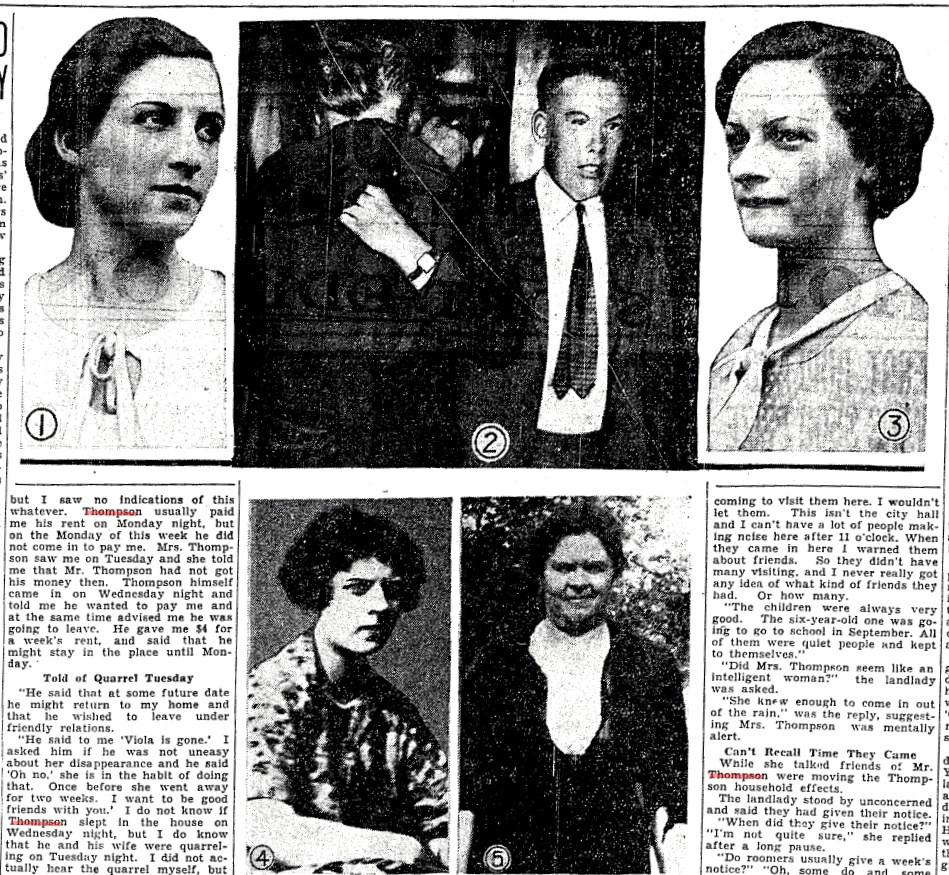On Thursday, July 19, 1934, three boys in North York made a horrific discovery.
Near the corner of Bayview Avenue and Blythwood Road – at that time a rural area – they were caught in a sudden thunderstorm. They dove for cover under a lilac bush and found the body of a woman. Her clothing was torn and her limbs were scratched and bruised. The boys immediately ran to a nearby house whose owner phoned the police.
Soon the area was swarming with police officers, detectives and reporters. Near the body was a bloodstained rock. There were tire tracks on the ground but rain had washed away any footprints that might have been there. An autopsy would reveal that the woman had been killed by blows to the head. The detectives believed she had been murdered somewhere else and then dumped under the bush. The press quickly dubbed the case “the Lilac Bush Murder.”
The following day the dead woman was identified as 29-year-old Viola Thompson (nee Rudd), born in Guelph but recently moved to Toronto. Her husband, Alwynne Edgar Thompson, with whom she’d had two children, was also from Guelph.
Insp. William H. Stringer, one of the Ontario Provincial Police department’s top investigators, and Insp. E. Boyd of the Toronto Police went to Guelph to look into the Thompsons’ background. They had already learned an intriguing bit of information: the day before Viola’s body was found, Alwynne had applied for a marriage licence at Toronto City Hall, claiming to be single. He apparently intended to marry a woman named Alice Helen Carey on Saturday, July 21.
Consequently, he had been arrested on a charge of perjury for making a false statement on an official document. Because Thompson was in custody, he could not attend Viola’s funeral or her burial in Toronto’s Mount Pleasant Cemetery.
With the assistance of Guelph Police, the visiting detectives spoke to friends and relatives of the slain woman. Among them were Alwynne’s sister Evelyn Emeny of Perth Street and his brother Stanley who lived on Eramosa Road. Viola and her sister-in-law, 15-year-old Grace Thompson, had visited him the Monday before the murder. They’d left after 10 p.m. to go back to Toronto.
According to coverage by Guelph and Toronto newspapers, the Lilac Bush Murder was “shrouded in mysterious circumstances.”
Thompson said he last saw Viola on the evening of Tuesday, July 17, when she left their apartment on Carlton Street to get groceries. But family members in Guelph told investigators Alwynne and Viola had not been getting along and weren’t living together. Grace said they quarreled frequently, especially over money. She also said the morning after the body was found, Alwynne took a suit to the cleaners. He usually cleaned and pressed his own suit to save money.
There was no wedding ring on the victim’s finger. Thompson claimed she had given it to him on Saturday, July 14, so he could pawn it because they needed money. But Viola’s father, Robert Rudd, said he’d seen it on her finger when she visited him just before the murder.
At the coroner’s inquest, Alice Carey testified she’d met Thompson the previous spring. She said she was unaware he was already married, and she had seen him write “single” on the marriage certificate. She said she didn’t know he put a false address on the document. Nor did she know that when he put his full name on the paper, he changed Edgar to Edward. When Thompson was asked why he didn’t tell Alice he already had a wife and children, he replied that he’d intended to tell her later.
Thompson’s lawyer made the curious observation that if a widower were technically single, then Thompson might very well have been making a factual claim on the certificate, as the doctor performing the autopsy determined Viola been dead for 18 to 24 hours when the boys found her. That seemed a moot point to a judge who sentenced Thompson to six to 12 months in the Ontario Reformatory in Guelph for perjury.
Meanwhile, the police conducted a lengthy investigation.
Thompson was still in the OR in May of 1935 when he was formally charged with murder. He was transferred to Toronto’s Don Jail. He went on trial in October of 1935, when the prosecution believed it had enough evidence for a conviction.
Thompson admitted he had been seeing other women even before he met Alice, but said he’d done that because Viola had been going out with other men. He claimed that when he confronted her about her relationship with a man she called Grandpa, she told him to mind his own business.
A storekeeper testified that on the night Viola had allegedly gone out for groceries, he had seen her in a black sedan with a man who was not her husband. That man, said Thompson’s defence counsel, was the real killer. But if such a man existed, police never found him.
Investigators concluded the tire tracks at the crime scene were made by a truck. Thompson worked periodically as a truck driver for the Loblaws company. However, he said that after working hours he did not have access to the yard in which the trucks were parked.
The Crown’s case was based entirely on circumstantial evidence, and the jury couldn’t come to a decision to convict or acquit. Thompson was tried again in January of 1936. This time the jury reached a unanimous verdict of not guilty. They had come to the conclusion that a man who would be dumb enough to take out a marriage certificate the day after his wife’s suspicious death couldn’t be clever enough to commit murder without leaving eyewitnesses or any hard evidence connecting him to the deed.
Even though two juries had failed to find Thompson guilty “beyond the shadow of a doubt,” many people in Guelph and Toronto believed he had killed Viola. No one else was ever tried for the crime. The Lilac Bush Murder remains unsolved.



